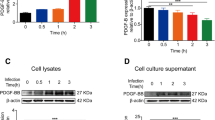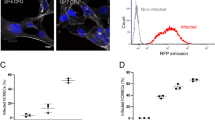Abstract
During the development of Escherichia coli K1 meningitis, interaction between E. coli invasion protein IbeA and surface protein(s) on human brain microvascular endothelial cells (HBMEC) is required for invasion and IbeA-mediated signaling. Here, an IbeA-binding protein was identified as polypyrimidine tract-binding protein (PTB)-associated splicing factor (PSF). The specific binding was confirmed by ligand overlay assay. The cell surface-expressed PSF was verified by the confocal microscopy. Recombinant PSF blocked E. coli K1 invasion of HBMEC effectively. Overexpression of PSF in the lentivirus-transducted HBMEC significantly enhanced E. coli K1 invasion. These results suggest that IbeA interacts with PSF for the E. coli K1 invasion of HBMEC.






Similar content being viewed by others
References
Akhmedov AT, Lopez BS (2000) Human 100-kDa homologous DNA-pairing protein is the splicing factor PSF and promotes DNA strand invasion. Nucleic Acids Res 28:3022–3030
Badger JL, Wass CA, Weissman SJ, Kim KS (2000) Application of signature-tagged mutagenesis for identification of Escherichia coli K1 genes that contribute to invasion of human brain microvascular endothelial cells. Infect Immun 68:5056–5061
Bladen CL, Udayakumar D, Takeda Y, Dynan WS (2005) Identification of the polypyrimidine tract binding protein-associated splicing factor p54(nrb) complex as a candidate DNA double-strand break rejoining factor. J Biol Chem 280:5205–5210
Bonacorsi S, Clermont O, Houdouin W, Cordevant C, Brahimi N, Marecat A, Tinsley C, Nassif X, Lange M, Bingen E (2003) Molecular analysis and experimental virulence of french and North American Escherichia coli neonatal meningitis isolates: Identification of a new virulent clone. J Infect Dis 187:1895–1906
Braun L, Ghebrehiwet B, Cossart P (2000) gC1q-R/p32, a C1q-binding protein, is a receptor for the InlB invasion protein of Listeria monocytogenes. EMBO J 19:1458–1466
Chen M, Li W, Fan J, Kasahara N, Woodley D (2003) An efficient gene transduction system for studying gene function in primary human dermal fibroblasts and epidermal keratinocytes. Clin Exp Dermatol 28:193–199
Chen YH, Chen SHM, Jong A, Zhou ZY, Li W, Suzuki K, Huang SH (2002) Enhanced Escherichia coli invasion of human brain microvascular endothelial cells is associated with alternations in cytoskeleton induced by nicotine. Cell Microbiol 4:503–514
Chung JW, Hong SJ, Kim KJ, Goti D, Stins MF, Shin S, Dawson VL, Dawson TM, Kim KS (2003) 37-kDa laminin receptor precursor modulates cytotoxic necrotizing factor 1-mediated RhoA activation and bacterial uptake. J Biol Chem 278:16857–16862
Dye BT, Patton JG (2001) An RNA recognition motif (RRM) is required for the localization of PTB-associated splicing factor (PSF) to subnuclear speckles. Exp Cell Res 263:131–144
Gower HJ, Moore SE, Dickson G, Elsom VL, Nayak R, Walsh FS (1989) Cloning and characterization of a myoblast cell-surface antigen defined by 24.1D5 monoclonal-antibody. Development 105:723–731
Hoffman JA, Badger JL, Zhang Y, Huang SH, Kim KS (2000) Escherichia coli K1 aslA contributes to invasion of brain microvascular endothelial cells in vitro and in vivo. Infect Immun 68:5062–5067
Huang SH, Chen YH, Fu Q, Stins M, Wang Y, Wass C, Kim KS (1999) Identification and characterization of an Escherichia coli invasion gene locus, ibeB, required for penetration of brain microvascular endothelial cells. Infect Immun 67:2103–2109
Huang SH, Jong AY (2001) Cellular mechanisms of microbial proteins contributing to invasion of the blood–brain barrier. Cell Microbiol 3:277–287
Huang SH, Stins MF, Kim KS (2000) Bacterial penetration across the blood-brain barrier during the development of neonatal meningitis. Microb Infect 2:1237–1244
Huang SH, Wan ZS, Chen YH, Jong AY, Kim KS (2001) Further characterization of Escherichia coli brain microvascular endothelial cell invasion gene ibeA by deletion, complementation, and protein expression. J Infect Dis 183:1071–1078
Kim KJ, Chung JW, Kim KS (2005) 67-kDa laminin receptor promotes internalization of cytotoxic necrotizing factor 1-expressing Escherichia coli K1 into human brain microvascular endothelial cells. J Biol Chem 280:1360–1368
Kim KS (2003) Pathogenesis of bacterial meningitis: from bacteraemia to neuronal injury. Nat Rev Neurosci 4:376–385
Kim KS, Itabashi H, Gemski P, Sadoff J, Warren RL, Cross AS (1992) The K1 capsule is the critical determinant in the development of Escherichia coli meningitis in the rat. J Clin Invest 90:897–905
Patton JG, Porro EB, Galceran J, Tempst P, Nadalginard B (1993) Cloning and characterization of PSF, a novel premessenger RNA splicing factor. Gen Develop 7:393–406
Peng R, Dye BT, Perez I, Barnard DC, Thompson AB, Patton JG (2002) PSF and p54(nrb) bind a conserved stem in U5 snRNA. RNA 8:1334–1347
Prasadarao NV, Srivastava PK, Rudrabhatla RS, Kim KS, Huang SH, Sukumaran SK (2003) Cloning and expression of the Escherichia coli K1 outer membrane protein A receptor, a gp96 homologue. Infect Immun 71:1680–1688
Prasadarao NV, Wass CA, Hacker J, Jann K, Kim KS (1993) Adhesion of S-fimbriated Escherichia coli to brain glycolipids mediated by SfaA gene-encoded protein of S-fimbriae. J Biol Chem 268:10356–10363
Prasadarao NV, Wass CA, Kim KS (1997) Identification and characterization of S Fimbria-binding sialoglycoproteins on brain microvascular endothelial cells. Infect Immun 65:2852–2860
Prasadarao NV, Wass CA, Stins MF, Shimada H, Kim KS (1999) Outer membrane protein A-promoted actin condensation of brain microvascular endothelial cells is required for Escherichia coli invasion. Infect Immun 67:5775–5783
Rosenberger U, Lehmann I, Weise C, Franke P, Hucho F, Buchner K (2002) Identification of PSF as a protein kinase C alpha-binding protein in the cell nucleus. J Cell Biochem 86:394–402
Shav-Tal Y, Cohen M, Lapter S, Dye B, Patton JG, Vandekerckhove J, Zipori D (2001) Nuclear relocalization of the pre-mRNA splicing factor PSF during apoptosis involves hyperphosphorylation, masking of antigenic epitopes, and changes in protein interactions. Mol Biol Cell 12:2328–2340
Shav-Tal Y, Zipori D (2002) PSF and p54(nrb)/NonO—multi-functional nuclear proteins. FEBS Lett 531:109–114
Sinclair JF, O’Brien AD (2002) Cell surface-localized nucleolin is a eukaryotic receptor for the adhesin intimin-gamma of enterohemorrhagic Escherichia coli O157 : H7. J Biol Chem 277:2876–2885
Srivastava M, Pollard HB (1999) Molecular dissection of nucleolin’s role in growth and cell proliferation: new insights. FASEB J 13:1911–1922
Stins MF, Prasadarao NV, Ibric L, Wass CA, Luckett P, Kim KS (1994) Binding characteristics of S-fimbriated Escherichia coli to isolated brain microvascular endothelial cells. Am J Pathol 145:1228–1236
Straub T, Grue P, Uhse A, Lisby M, Knudsen BR, Tange TO, Westergaard O, Boege F (1998) The RNA-splicing factor PSF/p54(nrb) controls DNA-topoisomerase I activity by a direct interaction. J Biol Chem 273:26261–26264
Wang Y (2002) The function of OmpA in Escherichia coli. Biochem Biophys Res Commun 292:396–401
Wang Y, Huang SH, Wass CA, Stins MF, Kim KS (1999) The gene locus yijP contributes to Escherichia coli K1 invasion of brain microvascular endothelial cells. Infect Immun 67:4751–4756
Watt S, Lanotte P, Mereghetti L, Moulin-Schouleur M, Picard B, Quentin R (2003) Escherichia coli strains from pregnant women and neonates: intraspecies genetic distribution and prevalence of virulence factors. J Clin Microbiol 41:1929–1935
Weiser JN, Gotschlich EC (1991) Outer membrane protein A (OmpA) contributes to serum resistance and pathogenicity of Escherichia coli K-1. Infect Immun 59:2252–2258
Zhang JR, Tuomanen E (1999) Molecular and cellular mechanisms for microbial entry into the CNS. J Neurovirol 5:591–603
Zolotukhin AS, Michalowski D, Bear J, Smulevitch SV, Traish AM, Peng R, Patton J, Shatsky IN, Felber BK (2003) PSF acts through the human immunodeficiency virus type 1 mRNA instability elements to regulate virus expression. Mol Cell Biol 23:6618–6630
Acknowledgments
We thank Dr. Kwang S. Kim for providing brain endothelial cells, Dr. Yu-Zhou Yang for anti-His tag monoclonal antibodies, Dr. Wei Li for the lentivirus transduction system and Dr. James G. Patton for PSF constructs and antibodies. This project is financially supported by Public Health Service grants R01-AI40635 (S.H.H.) and R01-NS047599 (A.J.).
Author information
Authors and Affiliations
Corresponding author
Additional information
Y. Zou and L. He contributes equally to this work.
Rights and permissions
About this article
Cite this article
Zou, Y., He, L., Wu, CH. et al. PSF is an IbeA-binding protein contributing to meningitic Escherichia coli K1 invasion of human brain microvascular endothelial cells. Med Microbiol Immunol 196, 135–143 (2007). https://doi.org/10.1007/s00430-006-0034-x
Received:
Published:
Issue Date:
DOI: https://doi.org/10.1007/s00430-006-0034-x




